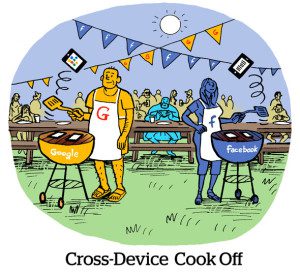“Hey PMax, can you write this article for me?”
We’re not quite there yet – but Performance Max, Google’s AI-based ad product, is getting closer.
On Thursday, Google announced a suite of updates to PMax that expand its generative AI creative capabilities.
Google first introduced AI-generated creative in PMax late last year. But the creative was basic, like stills of an object or text generation for metadata, search keywords and product descriptions.
The new update brings more complex settings, such as images with depth and multiple people in the foreground and background. PMax will also auto-generate videos out of static image assets.
PMax is focused on two interconnected applications of AI: predictive and generative capabilities, said Brendon Kraham, Google’s VP of global Search Ads and commerce.
The “predictive” element, which was built in from the start, involves allowing Google’s machine learning to find new customers on the grounds that Google can more effectively predict valuable audiences than a brand’s human ad buyers. The “generative” element is coming into play now and has made a lot of progress even in just the past three months.
PMax was created to help brands keep up with the pace of consumer trends online, Kraham told AdExchanger.
“And also, to be quite frank, there’s the complexity of our own systems,” he added, since without PMax marketers must run many campaigns across different Google products – YouTube, Search, the Google Display Network, Gmail, Maps, etcetera – to reach the same number of people.
The new creatives
AI-generated creative assets are an important part of Google’s strategy to boost adoption of PMax. For instance, Google is also expanding an “Ad Strength” meter, which tells advertisers if their PMax campaigns are “Poor,” “Average,” “Good,” “Excellent” or “Incomplete.”
To achieve “Excellent,” advertisers must designate the metrics they care about most, such as new customer acquisition, say, or store sales based on a merchant’s first-party data. They also have to share their targeting parameters and metadata to steer PMax’s AI, as well as a variety of creative assets, including videos and images of different types and sizes to feed the system.
Advertisers need specific assets to fill certain slots, like a square image, typical display banner formats, product listings and other creative items that work best in more niche Google products, like Maps and Gmail.
Kraham said AI-generated creative is an effective way to “fill the gaps” in those formats. And now with video generation, any merchant with a product listing feed can easily animate an image into a video to fit those inventory opportunities, namely on YouTube.
Here to steer
But what about control? A lack of transparency and control is one of the top concerns advertisers have when it comes to using PMax.
Enter “steering,” which is the new nomenclature for how advertisers can preset or control campaigns up front, since there isn’t the ability for mid-flight optimization. Remember, the whole point of PMax is that it optimizes better than that a hands-on-keyboard ad trader.
One form of steering is for advertisers to input their first-party data (“find more of these types of people”) and the conversion types they want for the campaign. A car company might want to generate test drive signups, say, or simply do new customer prospecting.
But creative itself is a kind of steering mechanism, too, within PMax at least. The creative assets that buyers share with the platform informs the machine learning system about their preferred audiences and media channels.
Some advertisers, for example, deliberately attempt to reverse engineer PMax’s targeting decisions by not uploading all of the necessary creative assets as a form of steering.
If a brand uses PMax but doesn’t want to impact its other YouTube campaigns, for example, it could deliberately not include video assets, thus preventing PMax from serving to YouTube. An advertiser might also try to discern whether PMax generates sales by retargeting people via the display network who searched for the brand or visited the site. PMax sees those as good conversions, when the brand might prefer to convert organically.
That kind of unintended steering will get more difficult now, since PMax will begin turning static product images into short videos, anyways.
The full fleet
Increasingly, however, Google is growing more confident with PMax as a default vehicle for advertisers – and pushing back against steering hacks by auto-generating videos from images or by clipping videos that already exist. One brand might upload only longer video ads so as to avoid advertising within YouTube Shorts. But PMax will simply turn that brand’s video ad into a Shorts-sized video nugget.
Google will also use its creative AI to zoom in or out on a video to fit any format across mobile, desktop or CTV.
“If you do hold back those elements, you’re not going to see the same performance gains,” Kraham said, when asked about advertisers deliberately leaving creative formats blank in a PMax campaign setup. “That’s why we have things like the ‘Ad Strength’ rating to help indicate that fact.”
When PMax emerged from beta in 2021, Google’s recommendation to advertisers was to use the product while still maintaining their own channel-specific campaigns.
Today, the best practice is to use what Google internally calls “the power pair” of PMax and Search together, Kraham said.
With the new AI-powered video creative feature, Google’s other properties – and YouTube is the biggie – might as well be folded into PMax now instead of treated as individual channels per Google’s guidance.
Google’s advice, to paraphrase, is for advertisers to get out of their own way and embrace the legit steering mechanisms for PMax across channels.
“We certainly think the best way to maximize the performance of PMax is to have all the assets to run across campaigns,” Kraham said.


















